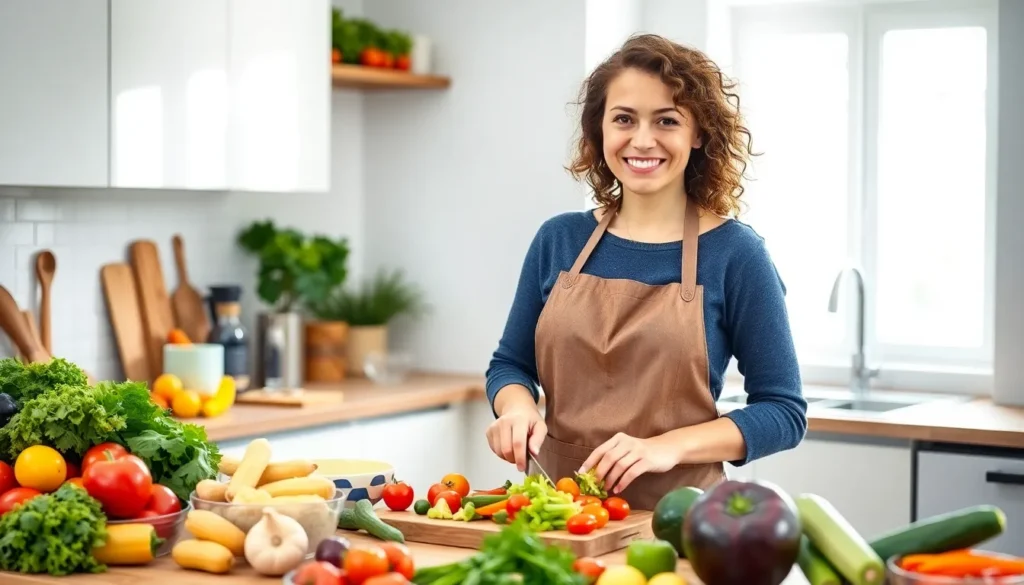Cooking can feel like stepping into a high-stakes competition, where the secret ingredient is often just a sprinkle of confidence. Mastering basic cooking techniques is like finding the cheat code to culinary success. Whether it’s sautéing veggies or boiling pasta, these skills can turn a kitchen rookie into a home chef extraordinaire.
Table of Contents
ToggleBasic Cooking Techniques
Mastering cooking techniques enhances culinary skills and boosts confidence. Sautéing involves cooking food quickly in a small amount of fat over high heat. Chefs often use this method for vegetables and proteins to develop flavors and retain textures.
Boiling encompasses cooking food by immersing it in rapidly bubbling water. This technique works well for pasta and vegetables, ensuring they cook evenly while maintaining their nutritional value.
Baking features cooking food using dry heat in an oven. This method is popular for bread, pastries, and casseroles, enabling ingredients to meld and flavor to develop.
Grilling involves cooking food over direct heat, often on a grill or grill pan. This technique adds a distinct smoky flavor to meats and vegetables, enhancing their taste profiles.
Roasting surrounds food with dry heat in an oven, cooking ingredients evenly from all sides. Chefs often roast meats and root vegetables, achieving a caramelized exterior while preserving moisture inside.
Steaming employs the power of vapor to cook food gently. Ideal for vegetables and fish, this technique retains nutrients and promotes a healthy cooking approach.
Frying, either by submerging food in hot oil (deep frying) or cooking in a small amount of oil (pan frying), creates a crispy texture. This method is widely used for dishes like fries and fried chicken, delivering satisfying crunch and flavor.
Practicing these techniques builds proficiency and lays the foundation for more advanced cooking skills. Each method offers unique benefits and flavors, providing a variety of options for any recipe.
Preparation Methods

Preparation methods play a crucial role in cooking, enhancing flavors and textures in dishes. Mastering these techniques simplifies meal preparation and boosts cooking confidence.
Chopping and Slicing
Chopping and slicing form the foundation of many recipes. Chopping involves cutting food into small, uniform pieces, which promotes even cooking. Slicing refers to cutting ingredients into thin pieces, ideal for vegetables and meats. Maintaining consistent size ensures better heat distribution and texture. Knives should remain sharp for improved precision and safety. For instance, julienne cuts provide attractive presentation while allowing quick cooking, particularly in stir-fries. Practicing these techniques also increases speed, making meal prep more efficient and enjoyable.
Peeling and Dicing
Peeling and dicing contribute to the overall preparation of ingredients. Peeling removes skins or outer layers from fruits and vegetables, enhancing their taste and texture. Dicing involves cutting food into small cubes, perfect for even cooking in soups or salads. Using a paring knife or vegetable peeler makes the peeling process easy. Consistently cutting ingredients into uniform dice promotes thorough cooking and visual appeal. Creating a mirepoix, a mix of diced onions, carrots, and celery, showcases these techniques while forming a flavor base for many dishes. Mastering these skills results in well-prepped, flavorful meals.
Cooking Methods
Mastering various cooking methods is essential for developing strong culinary skills. Each technique offers unique advantages and enhances the flavors of dishes.
Boiling and Steaming
Boiling is a straightforward method that utilizes hot water to cook foods quickly. Commonly, cooks boil pasta, vegetables, and grains. Steaming maintains nutrients and textures, making it suitable for vegetables and fish. Both methods are effective for preparing healthy meals without additional fats. Cooking times vary; for example, pasta typically takes 8-12 minutes, while steaming vegetables often takes 5-10 minutes.
Sautéing and Stir-Frying
Sautéing involves cooking foods quickly in a small amount of oil over medium to high heat. Chefs often sauté vegetables and proteins to enhance their flavors. Stir-frying shares similarities but utilizes a wok and higher heat, making it ideal for quick-cooking proteins with vegetables. These techniques promote browning, adding depth to dishes. Standard cooking times range from 3-10 minutes, depending on the ingredients used.
Baking and Roasting
Baking employs dry heat in an oven, suitable for various foods like bread, pastries, and casseroles. Roasting, however, involves cooking foods like meats and vegetables at higher temperatures to achieve caramelization. Both methods enhance flavors through Maillard reactions, making meals more exciting. Baking times can range from 20-60 minutes, while roasting typically requires 30-90 minutes depending on the dish’s size and composition.
Flavoring Techniques
Flavoring techniques elevate dishes, enhancing taste and presentation. Mastering these methods opens new culinary dimensions and ensures meals are memorable.
Seasoning and Marinating
Seasoning involves adding salt, herbs, and spices to boost flavor. Utilizing salt appropriately enhances all other flavors in a dish. Herbs like basil and thyme infuse freshness, while spices such as cumin and paprika offer warmth and depth. Marinating, on the other hand, involves soaking ingredients in a flavorful liquid for extended periods. This technique allows proteins to absorb flavors, making chicken and fish more robust. A marinade generally includes an acid, like vinegar or citrus juice, along with oils and seasonings. Allowing meats to marinate for at least 30 minutes significantly improves their taste and tenderness.
Saucing and Garnishing
Saucing adds moisture and complexity to dishes. Sauces, such as béchamel or tomato sauce, complement pastas, meats, and vegetables while enhancing overall flavor. Creating sauces often involves reductions, where liquids like stock or wine are simmered until thickened. Garnishing, meanwhile, provides visual appeal, making a dish more enticing. Fresh herbs and edible flowers enhance aesthetics and flavor. Plating these garnishes thoughtfully transforms simple presentations into culinary artwork. Integrating well-executed sauces and garnishes creates harmony between flavor and presentation, elevating home-cooked meals.
Safety and Cleanup
Safety in the kitchen is crucial for a successful cooking experience. Practicing good habits and maintaining a clean workspace ensure efficiency and reduce risks.
Kitchen Safety Tips
Use sharp knives with a proper grip to enhance control while cutting. Always keep a first aid kit nearby for minor accidents. Store raw ingredients separately from cooked items to prevent cross-contamination. Wear appropriate attire, such as non-slip shoes and fitted clothing, to ensure safety while cooking. Clean spills immediately to avoid falls. Use oven mitts to handle hot cookware and avoid burns. Familiarize oneself with kitchen equipment to minimize misuse. Follow cooking temperatures to ensure food safety.
Cleaning and Maintenance
Wipe down surfaces after meal prep to maintain hygiene. Utilize hot, soapy water for washing dishes to remove bacteria. Regularly empty trash to prevent odors and pest issues. Store utensils and equipment in designated areas to keep the kitchen organized. Inspect appliances frequently to ensure they function correctly. Ensure cutting boards remain sanitized after use to avoid cross-contamination. Use non-toxic cleaners for safe maintenance of cooking areas. Proper care prolongs the life of kitchen items and promotes a pleasant cooking environment.
Mastering basic cooking techniques is a game changer for anyone looking to elevate their culinary skills. By gaining confidence in fundamental methods like sautéing, boiling, and baking, home cooks can explore a world of flavors and textures. These techniques not only simplify meal preparation but also enhance the overall dining experience.
Incorporating effective preparation methods and flavoring techniques further enriches dishes, making meals memorable. Prioritizing kitchen safety and cleanliness ensures a smooth cooking process, allowing cooks to focus on creativity and enjoyment. With practice and the right approach, anyone can transform their kitchen into a space of culinary exploration and delight.





